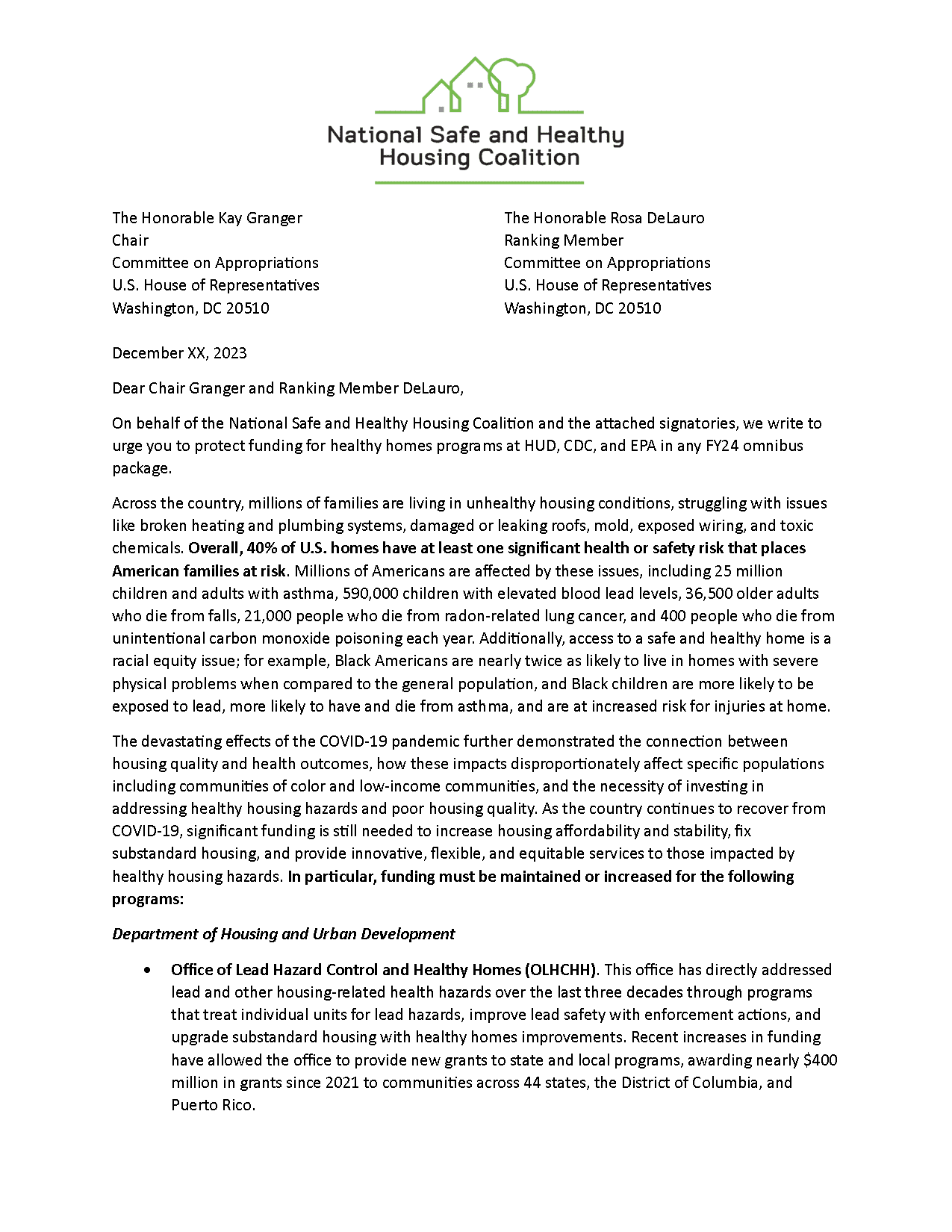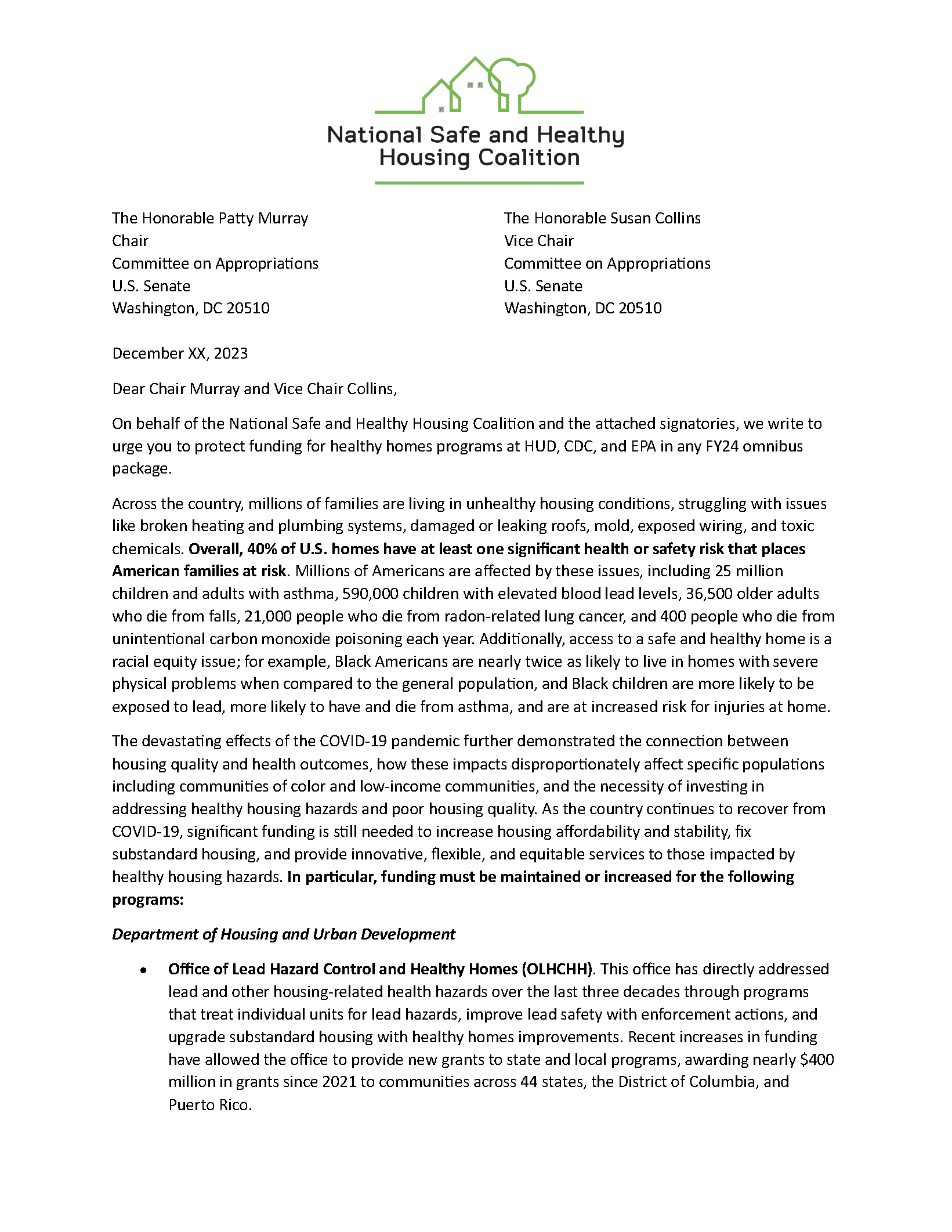National Safe and Healthy Housing Coalition
Action Letter Archive 2023
This page archives the action letters sent by the National Safe and Healthy Housing Coalition in a single location, organized by date.
The National Safe and Healthy Housing Coalition is a broad, voluntary coalition working to improve housing conditions nationwide through education and outreach to key national stakeholders and federal public decision-makers. The coalition promotes policies for safe and healthy housing in the United States with special emphasis on those who are disproportionately impacted.
Join the National Safe and Healthy Housing Coalition.
2023
November 20 (Draft): FY23 Appropriations Letters to the U.S. House of Representatives to support healthy homes programs at the Centers for Disease Control and Prevention, the U.S. Environmental Protection Agency (EPA) and the U.S. Department of Housing and Urban Development (HUD)
Extract: Across the country, millions of families are living in unhealthy housing conditions, struggling with issues like broken heating and plumbing systems, damaged or leaking roofs, mold, exposed wiring, and toxic chemicals. Overall, 40% of U.S. homes have at least one significant health or safety risk that places American families at risk. Millions of Americans are affected by these issues, including 25 million children and adults with asthma, 590,000 children with elevated blood lead levels, 36,500 older adults who die from falls, 21,000 people who die from radon-related lung cancer, and 400 people who die from unintentional carbon monoxide poisoning each year. Additionally, access to a safe and healthy home is a racial equity issue; for example, Black Americans are nearly twice as likely to live in homes with severe physical problems when compared to the general population, and Black children are more likely to be exposed to lead, more likely to have and die from asthma, and are at increased risk for injuries at home. The devastating effects of the COVID-19 pandemic further demonstrated the connection between housing quality and health outcomes, how these impacts disproportionately affect specific populations including communities of color and low-income communities, and the necessity of investing in addressing healthy housing hazards and poor housing quality. As the country continues to recover from COVID-19, significant funding is still needed to increase housing affordability and stability, fix substandard housing, and provide innovative, flexible, and equitable services to those impacted by healthy housing hazards.
November 20 (Draft): FY23 Appropriations Letters to the U.S. House of Representatives to support healthy homes programs at the Centers for Disease Control and Prevention, the U.S. Environmental Protection Agency (EPA) and the U.S. Department of Housing and Urban Development (HUD)
Extract: Across the country, millions of families are living in unhealthy housing conditions, struggling with issues like broken heating and plumbing systems, damaged or leaking roofs, mold, exposed wiring, and toxic chemicals. Overall, 40% of U.S. homes have at least one significant health or safety risk that places American families at risk. Millions of Americans are affected by these issues, including 25 million children and adults with asthma, 590,000 children with elevated blood lead levels, 36,500 older adults who die from falls, 21,000 people who die from radon-related lung cancer, and 400 people who die from unintentional carbon monoxide poisoning each year. Additionally, access to a safe and healthy home is a racial equity issue; for example, Black Americans are nearly twice as likely to live in homes with severe physical problems when compared to the general population, and Black children are more likely to be exposed to lead, more likely to have and die from asthma, and are at increased risk for injuries at home. The devastating effects of the COVID-19 pandemic further demonstrated the connection between housing quality and health outcomes, how these impacts disproportionately affect specific populations including communities of color and low-income communities, and the necessity of investing in addressing healthy housing hazards and poor housing quality. As the country continues to recover from COVID-19, significant funding is still needed to increase housing affordability and stability, fix substandard housing, and provide innovative, flexible, and equitable services to those impacted by healthy housing hazards.

